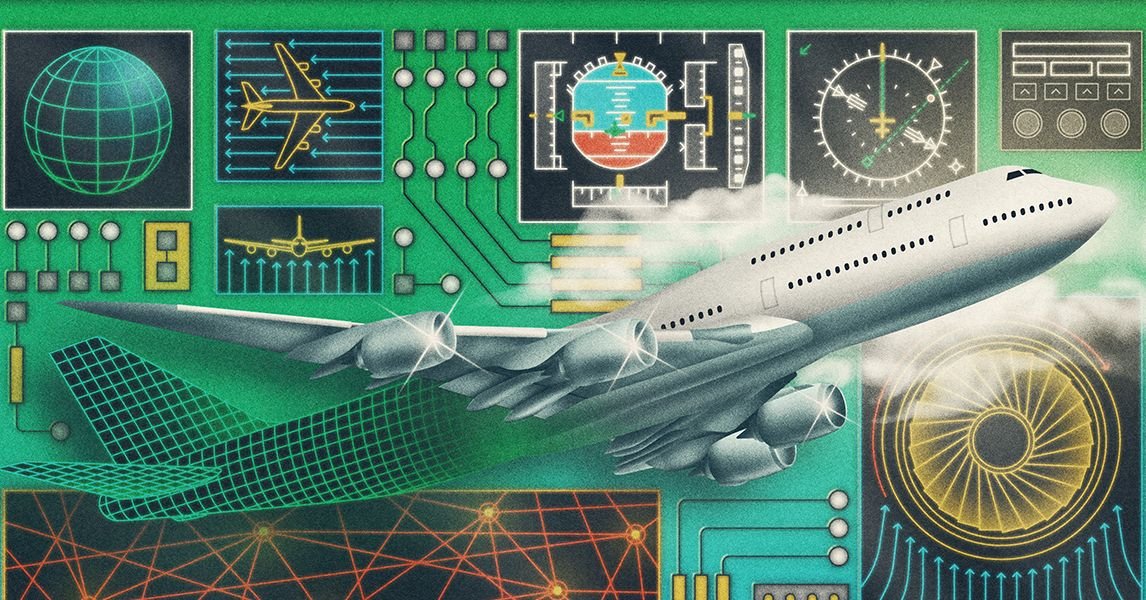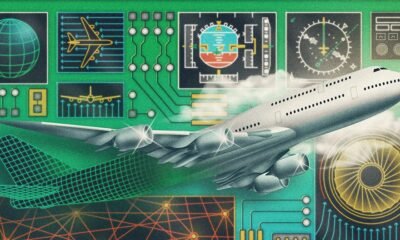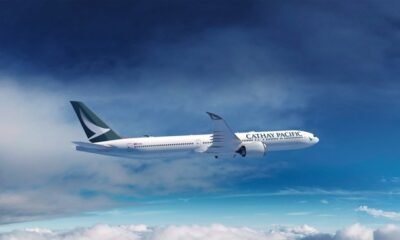Flight Buzz
Service to London Heathrow Has a Date

IndiGo has announced that it will be commencing its direct daily flights to London Heathrow on October 26. The airline will be operating the route on a Boeing 787-9 Dreamliner aircraft, it said.
IndiGo said it will be receiving five additional Boeing 787-9 Dreamliner aircraft during the ongoing financial year under its damp-lease arrangement with Norse Atlantic Airways. This, it said, “will enable the airline to launch new international routes while strengthening its existing long-haul network.”
Speaking at the earnings call last week, CEO Pieter Elbers had said the airline would be launching London and Copenhagen in the coming months. The airline has not clarified from which Indian city it would be flying to London Heathrow. IndiGo already operates flights to Manchester from Mumbai.
More IndiGoStretch Routes: IndiGo has also announced its plans to launch its business class product IndiGoStretch on flights operating on Delhi-Singapore and Mumbai-Singapore routes starting August 9. The airline will operate its two-class A321 aircraft on the routes.
Apart from this, IndiGo will also introduce the business class product on Delhi-Dubai route starting August 30, and on the Mumbai-Dubai route next month.
IndiGo’s Global Bet: In its earnings IndiGo had also said it would increase flights to Europe starting Se
Flight Buzz
Pegasus Airlines Bans Power Banks During Flights for Safety: Turkey’s New Regulations Reflect Growing Concerns Over Lithium-Ion Battery Risks in Aviation

Wednesday, August 6, 2025
Author: TTW News Desk
In a move aimed at enhancing flight safety, Turkish low-cost carrier Pegasus Airlines has introduced a significant policy change regarding the use of portable power banks during flights. The new regulation, which restricts passengers from using power banks during flights, has garnered attention amid growing concerns over the potential fire risks associated with lithium-ion batteries. Passengers are still allowed to carry power banks in their hand luggage, but with strict guidelines to ensure safety. This policy adjustment is part of a broader initiative by Turkish airlines, including Pegasus, to address the growing threat posed by devices powered by lithium batteries.
The decision follows several high-profile incidents globally, as well as a recent emergency involving Asiana Airlines. This evolving trend underscores the airline industry’s heightened awareness of the dangers these devices can pose in-flight, especially when batteries overheat or are improperly stored. As air travel resumes at full capacity, the move by Pegasus Airlines and other Turkish carriers highlights a critical step towards bolstering safety measures to prevent potential disasters mid-flight. The policy aligns with international standards while incorporating localized regulations aimed at ensuring a safer travel experience for passengers.
New Power Bank Regulations by Pegasus Airlines
- Ban on Power Bank Usage During Flights: Passengers are no longer allowed to use portable power banks during flights, though they can still carry them in their hand luggage.
- Packing Requirements: Power banks must be properly packed according to the airline’s guidelines. This ensures that they do not pose a risk of overheating or fire during the flight.
- Growing Concerns Over Lithium Batteries: The policy follows increased safety awareness surrounding lithium-ion batteries, which are widely used in power banks and other electronic devices.
The Rising Safety Concerns Around Lithium-Ion Batteries
Lithium-ion batteries, found in devices like power banks, laptops, and smartphones, have become a central point of concern for airlines and aviation safety regulators. The primary issue is the risk of overheating, which can lead to fires or even explosions. These incidents, although rare, can be catastrophic in-flight. According to experts, when these batteries overcharge, become damaged, or are exposed to extreme temperatures, they can catch fire, potentially leading to serious consequences for passengers and crew alike.
Pegasus Airlines’ decision to ban the use of power banks during flights is a proactive measure in response to these risks. While passengers can still bring power banks aboard, the airline’s strict guidelines on their storage ensure that these devices are securely packed in a way that minimizes the risk of fire.
This change is particularly important as the global aviation industry has seen an increase in the number of passengers carrying electronic devices. As such, airlines around the world have been tightening their rules regarding devices that are powered by lithium-ion batteries, with the goal of reducing the possibility of in-flight incidents.
International Responses to Lithium Battery Concerns
Pegasus Airlines is not alone in implementing stricter safety measures. Several other airlines, both in Turkey and internationally, have followed suit by restricting the use of high-capacity power banks and electronic devices with built-in lithium-ion batteries.
- Turkish Airlines: Just last week, Turkish Airlines imposed a ban on “smart luggage” containing non-removable lithium batteries. The new rule prohibits such bags from being checked in, though passengers may carry them as hand luggage if they remove the lithium battery beforehand. The battery must be stored separately in original packaging or a plastic sleeve to prevent any short circuits.
- Global Airlines: Many other international airlines, such as American Airlines, Delta, and Lufthansa, have similar restrictions in place. These airlines often allow power banks and electronic devices onboard but impose limits on their capacity. High-capacity power banks, in particular, are often banned from being used during flights.
The Asiana Airlines Incident: A Catalyst for Change
The recent safety incident with Asiana Airlines has further accelerated the need for stricter regulations. During a flight from Istanbul to Seoul, an emergency arose after a passenger dropped their power bank between seats. This incident raised significant safety concerns about the potential for battery overheating and the risk of fire mid-flight. The airline had to turn back midair over Kazakhstan as a precautionary measure, which underscored the need for tighter safety protocols regarding lithium-powered devices.
Following this event, Turkey’s Directorate General of Civil Aviation recommended that local carriers adopt measures similar to those implemented by Pegasus Airlines. The response was swift and coordinated, highlighting the importance of ensuring aviation safety as air travel volumes continue to rise.
The Role of Turkey’s Civil Aviation Authority
In Turkey, the Directorate General of Civil Aviation (DGCA) plays a crucial role in regulating airline safety policies. In the wake of the Asiana Airlines incident, the DGCA worked closely with airlines like Pegasus to implement new safety protocols that specifically address the risks posed by portable power banks and lithium-ion batteries.
Abdulkadir Uraloğlu, Turkey’s Minister of Transport, confirmed that the DGCA’s recommendation was aimed at creating a standardized set of safety practices that would prevent potential accidents involving power banks. The Turkish government’s proactive stance reflects the country’s commitment to ensuring that air travel remains as safe as possible for passengers and crew.
Why This Policy Matters for Passengers
For travelers, the new policy means that they will need to make adjustments when packing for their flights. Although the restrictions may initially seem inconvenient, the regulations are intended to ensure that all passengers can travel with peace of mind, knowing that safety risks are being minimized.
Travelers will need to ensure that their power banks are packed in accordance with the new guidelines. For example, if traveling with a power bank, it must be securely placed in hand luggage, and passengers should be aware of the airline’s capacity limits. This measure is an essential part of keeping the cabin free of potential hazards, particularly as air travel becomes more crowded in the coming years.
Conclusion: A Step Towards Safer Air Travel
Pegasus Airlines’ decision to ban the use of power banks during flights reflects a broader trend in the aviation industry toward stricter safety regulations regarding lithium-ion batteries. The policy aims to reduce the risk of fire or overheating incidents, ensuring that both passengers and crew are protected during air travel.
As other Turkish airlines, including Turkish Airlines, follow suit with similar safety measures, the industry is sending a strong message about the importance of adapting to emerging risks. The collaboration between airlines, aviation authorities, and safety regulators ensures that the global aviation industry remains vigilant in safeguarding passengers.
For travelers, it’s a reminder to pack smarter and be mindful of new restrictions, particularly when carrying electronic devices with lithium-ion batteries. As the aviation industry continues to evolve, passenger safety remains the top priority, and these regulatory changes are a necessary step in that direction.
Bullet Points:
- Pegasus Airlines bans power bank usage during flights for safety reasons.
- Power banks can still be carried in hand luggage but must be packed according to airline guidelines.
- Turkish Airlines follows suit by restricting smart luggage with non-removable lithium batteries.
- A recent Asiana Airlines incident highlighted the dangers of power bank use during flights.
- Turkey’s Directorate General of Civil Aviation recommends tighter safety measures for local airlines.
Flight Buzz
Birmingham Airport shuts runway and flights on hold due to ‘aircraft incident’

Check before travelling to airport, Birmingham Airport sayspublished at 15:06 British Summer Time
Breaking
Here’s the full statement from Birmingham Airport, published a short time ago on X:
“Following an aircraft incident, the runway is temporarily closed.
“We apologise for the inconvenience this will cause.
“We will keep passengers already at the airport informed and those due to travel later today are advised to check the status of their flight before coming to the airport.
“We will continue to issue updates when we can.”
Flight Buzz
The Tech That Keeps Planes Flying for Ultra-Long-Haul Flights

The increased wingspan is one reason the A350-900 can fly from New York to Singapore—the longest flight in the world—with just two engines. Another crucial factor is that, over the last 30 years, aircraft engines have become substantially more efficient, even though the fundamental turbine technology remains the same.
Improvements include advances in the manufacturing of lighter engine blades made of carbon-fiber composite that are twice the strength and significantly lighter than titanium blades; enhanced cooling systems; and sophisticated control programs that monitor crucial data during flight such as air pressure, temperature, airspeed, and more. The optimal location of engines on the wing has also been refined.
“If you look at the 747, with four engines—now you can provide the same amount of thrust on two engines that burn 20 percent to 30 percent less fuel than those engines that were produced 20 to 30 years ago,” says Cary Grant, an assistant professor of Aeronautical Science at Embry-Riddle Aeronautical University in Prescott, Arizona.
The difference lies in how the engines use airflow. Turbojet engines used in older aircraft force all incoming air through the engine core and combustion chambers, generating thrust by ejecting exhaust gases out the back at high speeds. This process used more energy and was much louder than newer engines.
Modern long-haul aircraft use what are called high-bypass engines, which use a system that allows a large volume of air to flow around the engine core. The thrust, then, is generated primarily by the large fan at the front of the engine—the part one can see by looking directly into it—as opposed to the exhaust shooting out the back. This design has greatly improved engine efficiency as the ratio of bypass air increased.
The new engines produce an extraordinary amount of power. The General Electric high-bypass engine, GEnx, which powers the Dreamliner, is almost as wide as a Boeing 737’s fuselage. According to GE’s website, the engine has a 10:1 bypass ratio, which means that 10 times more air goes around the outside of the engine rather than through the engine core for combustion.
Computer-aided design has also made the blades more efficient and stronger, allowing them to spin at 30,000 to 40,000 rpm. “You’ve got to be able to have structures that can withstand that type of rotational and torsional stress,” Grant says. Ceramic materials used in the engine core allow for higher internal operating temperatures than nickel-based super alloy metals, which are currently used in most engines.
The use of lightweight composite materials, namely carbon fiber, in the aircraft’s wings and fuselage has significantly reduced the overall weight of the aircraft. The less an aircraft weighs, the less energy is required to power it.
The overall designs of these aircraft are more aerodynamic as well. The wings on both the A350 and the Dreamliner variants are thinner than on previous generations, and the fuselage designs, notably the Dreamliner’s dolphin-like nose, generally create less drag.
In the cockpit, new technologies simplify pilot controls and problem-solving through advanced feedback systems, which help reduce pilot workload and increase performance. Today’s long-haul aircraft allow for semi-autonomous flight—in fact, the technology already exists for fully autonomous flights, even for large commercial aircraft.
Even the passenger experience has improved, although the pace of that technology may not have kept up with that of the airplane itself. The biggest difference between today’s commercial aircraft and previous generations is the ability to control cabin pressure, humidity, and air circulation. “[When] Boeing produced the 787, they were able to keep the atmosphere humidified,” says Grant. “Just that alone is a huge improvement for people—you know, after a nine- or 10-hour flight it used to feel like you had cornflakes in your nose.”
The other major improvement on long-haul flights, according to Grant? Today’s airline Wi-Fi is actually good.
-

 Brand Stories2 weeks ago
Brand Stories2 weeks agoBloom Hotels: A Modern Vision of Hospitality Redefining Travel
-

 Brand Stories2 weeks ago
Brand Stories2 weeks agoCheQin.ai sets a new standard for hotel booking with its AI capabilities: empowering travellers to bargain, choose the best, and book with clarity.
-

 Destinations & Things To Do2 weeks ago
Destinations & Things To Do2 weeks agoUntouched Destinations: Stunning Hidden Gems You Must Visit
-

 Destinations & Things To Do2 weeks ago
Destinations & Things To Do2 weeks agoThis Hidden Beach in India Glows at Night-But Only in One Secret Season
-

 AI in Travel2 weeks ago
AI in Travel2 weeks agoAI Travel Revolution: Must-Have Guide to the Best Experience
-

 Brand Stories1 month ago
Brand Stories1 month agoVoice AI Startup ElevenLabs Plans to Add Hubs Around the World
-

 Brand Stories4 weeks ago
Brand Stories4 weeks agoHow Elon Musk’s rogue Grok chatbot became a cautionary AI tale
-

 Brand Stories2 weeks ago
Brand Stories2 weeks agoContactless Hospitality: Why Remote Management Technology Is Key to Seamless Guest Experiences
-

 Asia Travel Pulse1 month ago
Asia Travel Pulse1 month agoLooking For Adventure In Asia? Here Are 7 Epic Destinations You Need To Experience At Least Once – Zee News
-

 AI in Travel1 month ago
AI in Travel1 month ago‘Will AI take my job?’ A trip to a Beijing fortune-telling bar to see what lies ahead | China













You must be logged in to post a comment Login